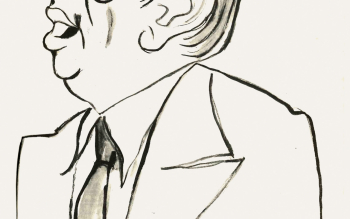From New Statesman:
 Somewhere within the mind of this dwarf-like sage, behind the thick spectacles, the angry eyes, the fleshy facial mask with its wide and sensual mouth, the decisive intellectual battle of our century is being fought in microcosm. Yet, despite the single-mindedness of Sartre’s aim and the logical symmetry of his intellectual development, no great thinker has been more misunderstood and provoked such violent and conflicting reactions. Sartre has been denounced as “unfathomably obscure” (Raymond Aron) and as “a deliberate vulgariser” (Merleau-Ponty). L’Être et le Néantwas once called “the most difficult philosophical work ever written”; yet L’Existentialisme Est Un Humanisme has sold more copies (150,000) than any other volume of modern philosophy. The Vatican has placed his works on the Index; yet Gabriel Marcel, himself a militant Catholic, regarded him as the greatest of French thinkers. The State Department found his novels subversive; but Les Mains Sales was the most effective counter-revolutionary play of the entire cold war. Sartre has been vilified by the Communists in Paris and fêted by them in Vienna. No great philosopher ever had fewer disciples; but no other could claim the intellectual conquest of an entire generation.
Somewhere within the mind of this dwarf-like sage, behind the thick spectacles, the angry eyes, the fleshy facial mask with its wide and sensual mouth, the decisive intellectual battle of our century is being fought in microcosm. Yet, despite the single-mindedness of Sartre’s aim and the logical symmetry of his intellectual development, no great thinker has been more misunderstood and provoked such violent and conflicting reactions. Sartre has been denounced as “unfathomably obscure” (Raymond Aron) and as “a deliberate vulgariser” (Merleau-Ponty). L’Être et le Néantwas once called “the most difficult philosophical work ever written”; yet L’Existentialisme Est Un Humanisme has sold more copies (150,000) than any other volume of modern philosophy. The Vatican has placed his works on the Index; yet Gabriel Marcel, himself a militant Catholic, regarded him as the greatest of French thinkers. The State Department found his novels subversive; but Les Mains Sales was the most effective counter-revolutionary play of the entire cold war. Sartre has been vilified by the Communists in Paris and fêted by them in Vienna. No great philosopher ever had fewer disciples; but no other could claim the intellectual conquest of an entire generation.
Amid the bitter hatreds and controversies of which Sartre has been the centre, his principal objective—and the logical concentration with which he has pursued it—has tended to become obscured. Around the man has grown a myth; and around the myth, foggy, concentric rings of intellectual prejudice. When we strip the layers, however, we find that increasingly rare—indeed, today, unique—phenomenon: a complete philosophical system, an interlocking chain of speculation which unites truth, literature and politics in one gigantic equation. In the late Thirties, Sartre was a young, under-paid, over-educated philosophy teacher in a smart Paris school, a member—and a typical one—of the most discontented, numerically inflated and socially dangerous group in the world: the French bourgeois intellectuals. He had studied Heidegger and Kierkegaard in Germany; he taught Descartes in France. Like all intellectuals, he asked himself the question: had his knowledge any relevance to the problems of his day? The Fascists were at the gates of Madrid; what was he supposed to do about it? Why had Blum failed? Did it matter that Stalin had seen fit to murder the Old Guard of the Bolsheviks? Why was capitalism in ruins, Hitler triumphant, the democracies afraid?
It is typical of Sartre that he began his search for the answers to these problems by reformulating them at an abstract level. La Nausée (1938), his first major work, is an imaginative inquiry into the problems of existence. Roquentin, its autobiographical and solitary hero, discovers that the bourgeois world in which he lives is senseless and incoherent. His past no longer exists, his future is unknown, his present unrelated; life has no pattern. Through Roquentin’s introspective reveries, Sartre presents his fundamental metaphysical image: a loathing for the incompleteness of existence in the world as he finds it, a longing for completeness which is both intelligible and creative. If Kafka’s The Trial epitomises the nightmare of the ordinary man in a hostile and incomprehensible world, La Nausée is the nightmare of the philosopher, in which physical fear is replaced by intellectual disgust.
More here. (Note: First published on 30 June 1956, a profile of the philosopher and the communist dilemma)
